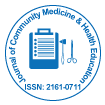Nuestro grupo organiza más de 3000 Series de conferencias Eventos cada año en EE. UU., Europa y América. Asia con el apoyo de 1.000 sociedades científicas más y publica más de 700 Acceso abierto Revistas que contienen más de 50.000 personalidades eminentes, científicos de renombre como miembros del consejo editorial.
Revistas de acceso abierto que ganan más lectores y citas
700 revistas y 15 000 000 de lectores Cada revista obtiene más de 25 000 lectores
Indexado en
- Índice Copérnico
- Google Académico
- sherpa romeo
- Revista GenámicaBuscar
- SeguridadIluminado
- Búsqueda de referencia
- Universidad Hamdard
- EBSCO AZ
- OCLC-WorldCat
- publones
- Fundación de Ginebra para la educación y la investigación médicas
- Pub Europeo
- ICMJE
Enlaces útiles
Revistas de acceso abierto
Comparte esta página
Abstracto
Determinants of Traditional Cauterization in Patients Visiting Massawa Hospital, Eritrea
Berhe Tesfai, Fitsum Kibreab, Mulugeta Russom, Lemlem Hussien, Adhanom Debesai, Saliem Mekonnen, Fnan Ghirmay
Background: Traditional cauterization, one of the ancient modalities of traditional medicine, has been practiced with the application of hot metal rods/knives over diseased body parts with the intention to treat different diseases. In Eritrea, a recent study reported a high prevalence of traditional cautery in patients visiting Massawa hospital and this study was conducted to explore determinants of traditional cautery using the data collected previously.
Methods: This was a hospital based cross sectional study in patients visiting Massawa hospital of Eritrea. Data was collected through face to face interview using structured questionnaire. Both univariate and multivariate analysis were carried out to identify determinants of cautery.
Results: The study enrolled 900 patients with a median age of 42 years (Interquartile range: 20). Those who were aged (adjusted Odds Ratio (aOR): 2.3; 95% CI: 1.5-3.5; p<0.001), had no access to health facility (aOR: 6.9; 95% CI: 3.5-13.8; p<0.001) and had poor availability of means of transportation to health facility (aOR: 5.0; 95% CI: 2.7-9.3; p<0.001) were more likely to use traditional cautery compared to their counterparts. On the other hand, having relatively higher educational level (aOR: 0.2; 95% CI 0.2-0.3; p<0.001), monthly income of above 1000 Eritrean Nakfa (aOR: 0.4; 95% CI: 0.3-0.6; p<0.001), employed (aOR: 0.7; 95% CI 0.5-0.9; p<0.005) and living in urban Massawa sub-zone (aOR: 3.0; 95% CI 1.9-4.7; p<0.001) were less likely to practice traditional cautery compared to their counterparts.
Conclusion: Higher illiteracy rate, older age, limited access to health facility, poor means of transportation and having lower monthly income were the main determinants for the higher prevalence of traditional cautery on patients visiting Massawa hospital of Eritrea.
Revistas por tema
- Agricultura y acuicultura
- Alimentación y Nutrición
- Bioinformática y biología de sistemas
- Bioquímica
- Ciencia de los Materiales
- Ciencia general
- Ciencias Ambientales
- Ciencias Clínicas
- Ciencias farmacéuticas
- Ciencias Médicas
- Ciencias Sociales y Políticas
- Ciencias Veterinarias
- Enfermería y atención sanitaria
- Física
- Genética y biología molecular
- Geología y Ciencias de la Tierra
- Ingeniería
- Inmunología y Microbiología
- Química
Revistas clínicas y médicas
- Anestesiología
- Biología Molecular
- Cardiología
- Cirugía
- Cuidado de la salud
- Dermatología
- Diabetes y Endocrinología
- Enfermedades infecciosas
- Enfermería
- Gastroenterología
- Genética
- Inmunología
- Investigación clínica
- Medicamento
- Microbiología
- Neurología
- Odontología
- Oftalmología
- Oncología
- Pediatría
- Toxicología

 English
English  Chinese
Chinese  Russian
Russian  German
German  French
French  Japanese
Japanese  Portuguese
Portuguese  Hindi
Hindi